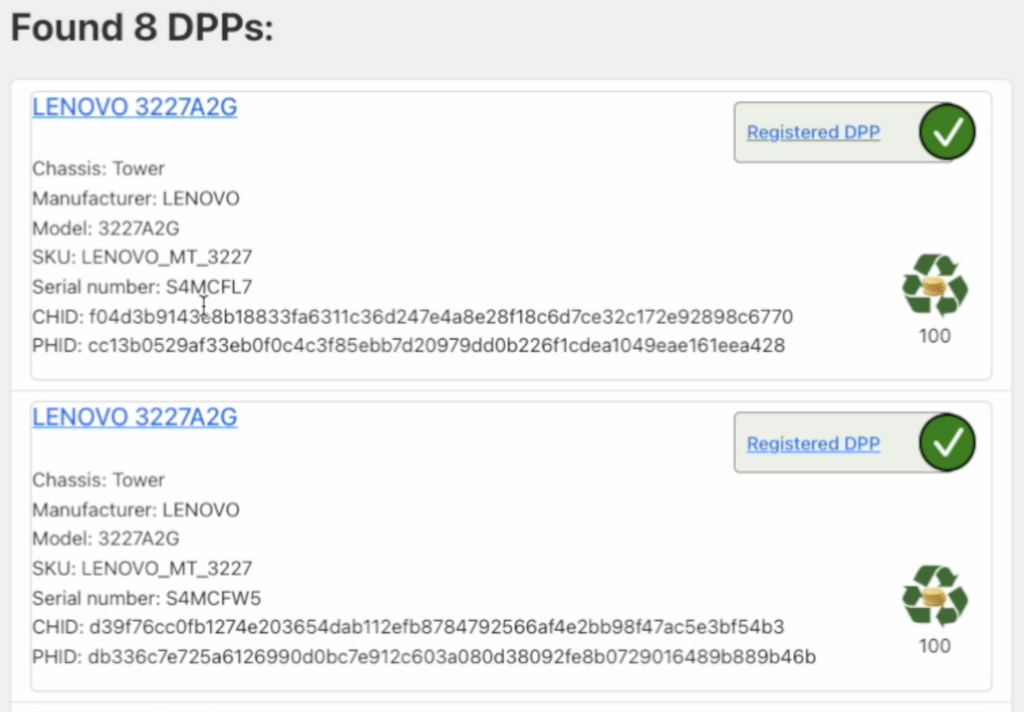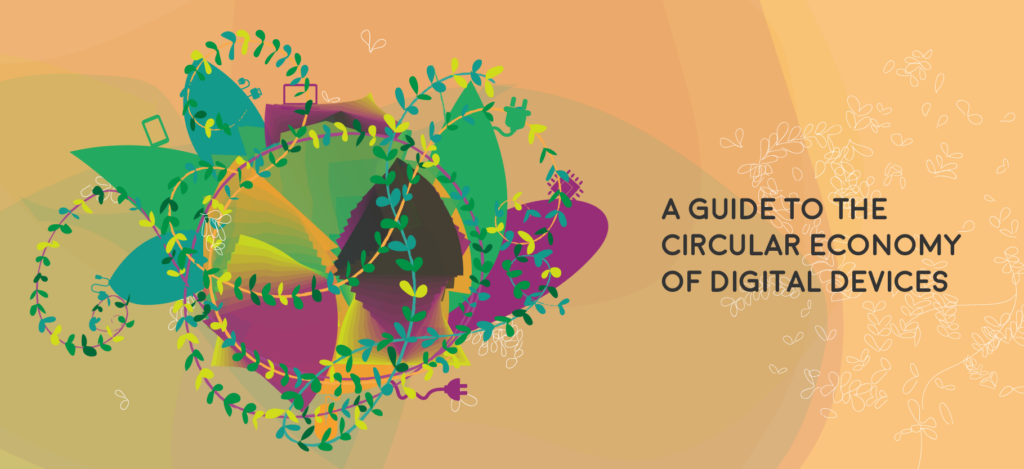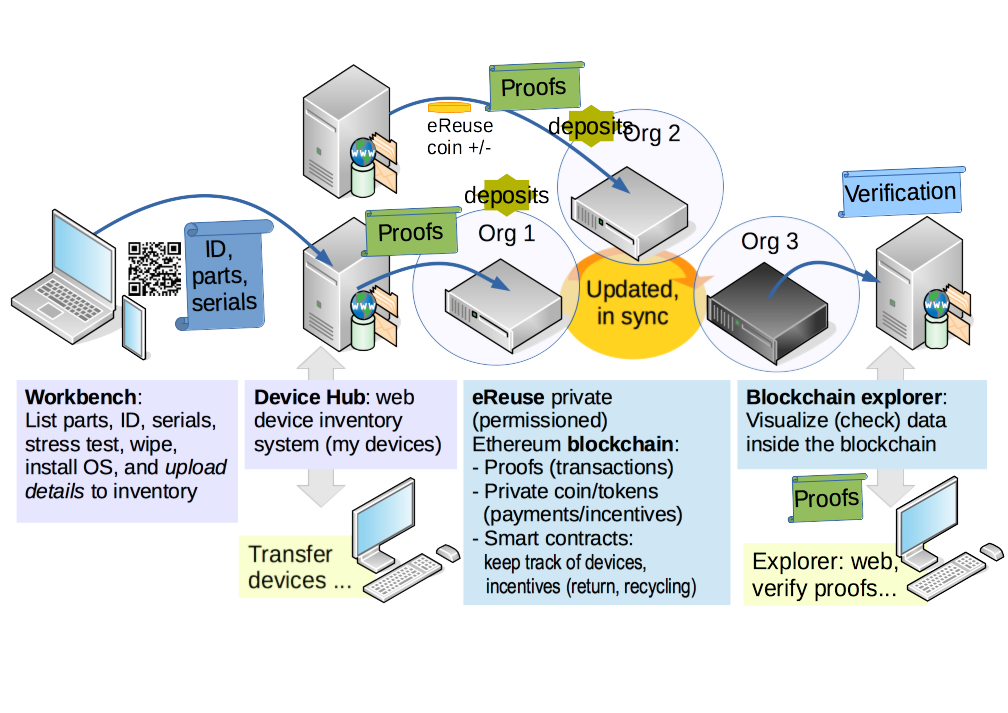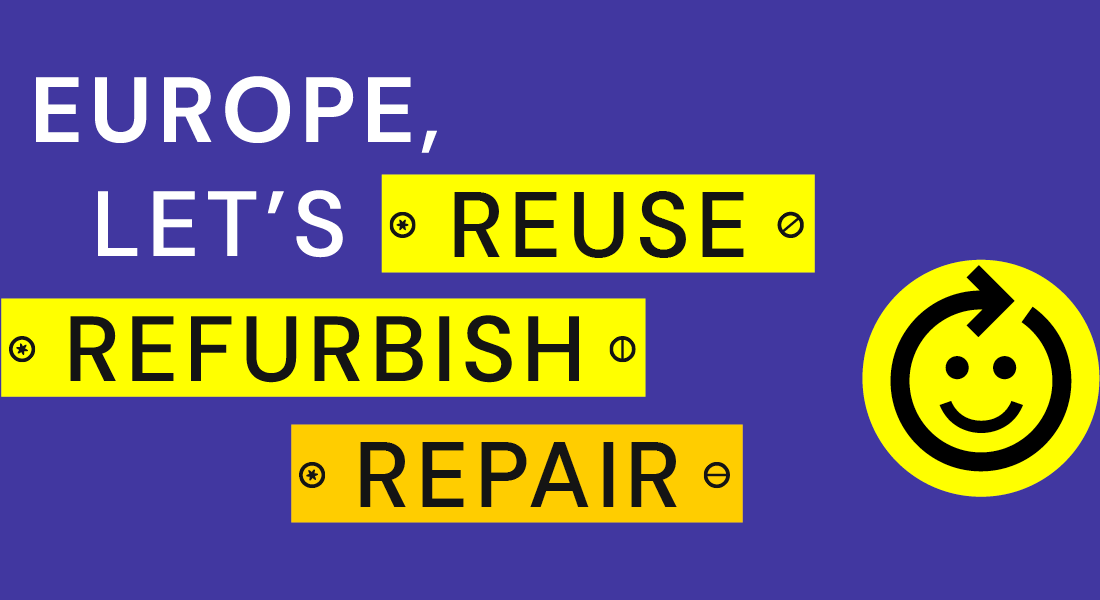Estamos trabajando en una nueva versión de DeviceHub, reimplementada en el marco de Django. ¡Te mantendremos informado!
Esta captura de pantalla es de un prototipo funcional, pero no es la versión final.
In our work supported by the NGI-Search project, we have achieved several advances in searching, discovering and accessing information about our digital devices. We have a digital product passport (DPP) that shows a history of all hardware configurations a device (a chassis) has or had over a lifespan, with the same chassis and serial but with perhaps different components due to repair, reconfiguration, upgrades, remanufacturing. We record key events of each product item’s lifespan and provide a public record for accountability.
We keep a so-called digital twin for the circular management of ICT devices. The digital information is kept in two sources, one database with details about each action and the documents that detail them, and a ledger or accounting book that builds on append-only storage (organized as a blockchain) so past events cannot be changed.
The DPP is a concept developed by the European Commission for the Sustainable Product Initiative and ecodesign (ESPR). Below there is a video demo of it.
A DPP search engine is an required component of the ESPR. The links in the figure and video below point to a separate DPP registry prototype where product models are registered as a requirement to enter the EU market.
The coins surrounded by a recycling logo represents, implemented as an ERC20 smart contract, a token deposit left by the manufacturer as part of an extended producer responsibility (EPR) scheme, under the principle of «the poluter pays». Manufacturers leave a deposit according to each product items entering a national market. This deposit waits for years until an accredited professional recycler records a proof of recycling, and auditor validates the processing and proofs, and then automatically and inexorably the deposit is transferred to that recycler, completing the process. Of course, all of these lifespan events are registered in the ledger, providing a transparency log of the circular economy of digital devices.
The software system will be released in March 2024.

(April 2023) We have joined the NGI-Search project to explore how to search, discover and access information about our digital devices.
We work with so-called digital twins for the circular management of ICT devices. The device twins provide identifiers, details & verifiability information (proofs) represented as a digital product passport (DPP).
The DPP is a concept developed by the European Commission for the Sustainable Product Initiative and ecodesign. More details will be coming soon.
A description of eReuse as case in the circular guide APC has published: “A guide to the circular economy of digital devices”, “Una guía sobre la economía circular de los dispositivos digitales”, “Guide de l’économie circulaire de nos appareils numériques”, October, 2021.

We are in a «slow motion» environmental crisis, in comparison with the COVID crisis. There are many more electronic devices than people, and the numbers strongly vary depending on the source. ITU-T estimates 13 billion end-users ICT goods in 2015 and forecast 20 billion by 2030 (ITU-T_L.1470). The production of an ICT good has many times higher environmental impact than usage over their whole lifespan (Life-Cycle Assessment of Consumer Electronics). For that reason, the circular economy aims at eliminating waste and the continual use of resources, and represents an strategy to transform industrial processes to be more sustainable.
The mission of the eReuse community, shared with the USOdy initiative, is the transition to a collaborative and circular consumption of electronics. Some aims to achieve this:
We have been busy implementing a distributed ledger as a distributed source of truth for the traceability of computer devices. Every relevant operation on a device (ownership transfer, recycling, etc) is logged in our permissioned blockchain. Moreover, it is programmed to generate Proofs, that act as attestations about a past action or state of a device.
The use of the blockchain can provide, apart from a multi-stakeholder traceability system, a flexible approach to enforcing incentives throughout a device life-cycle. In the Ledger project, we have developed an incentive scheme according to which a form of a deposit is included in every device transfer between participants. This strategy, to promote the reuse and recycle of the devices with a “Deposit return system”, has been shown for other resources to be the most effective and sustainable way to make a zero waste circular economy happen as it maximises the lifespan of devices as useful resources.
However, that needs a careful data collection and processing policy:
This way, the ledger does not store any personal data, just proofs of it, and thus only meaningful for those that already have it. We use smart contracts to count and record results agreed to be made public (e.g. statistical data) to measure circularity, such as durability metrics for models and manufacturers, but individual details are not recorded.

 In eReuse we definitely share the perspective of the Right to Repair campaign. The right is fundamental for reuse and for ensuring the longest lifespan of electronics, and even to give more usefulness and value to parts obtained from recycling. We joined the campaign!
In eReuse we definitely share the perspective of the Right to Repair campaign. The right is fundamental for reuse and for ensuring the longest lifespan of electronics, and even to give more usefulness and value to parts obtained from recycling. We joined the campaign!
